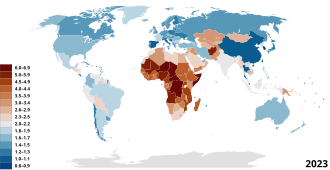
The total fertility rate (TFR) of a population is the average number of children that are born to a woman over her lifetime, if they were to experience the exact current age-specific fertility rates (ASFRs) through their lifetime, and they were to live from birth until the end of their reproductive life.
As of 2023, the total fertility rate varied widely across the world, from 0.7 in South Korea, to 6.1 in Niger.[1]
Fertility tends to be inversely correlated with levels of economic development. Historically, developed countries have significantly lower fertility rates, generally correlated with greater wealth, education, urbanization, and other factors. Conversely, in least developed countries, fertility rates tend to be higher. Families desire children for their labor and as caregivers for their parents in old age. Fertility rates are also higher due to the lack of access to contraceptives, generally lower levels of female education, and lower rates of female employment. It does not significantly correlate with any particular religion.
From antiquity to the beginning of the industrial revolution, around the year 1800, total fertility rates of 4.5 to 7.5 were common around the world.[2] 76-77,[1] After this TFR declined only slightly and up until the 1960’s the global average TFR was still 5.[3] Since then, global average TFR has dropped steadily to less than half that number, 2.3 births per woman in 2023.[1]
The United Nations predicts that global fertility will continue to decline for the remainder of this century and reach a below-replacement level of 1.8 by 2100, and that world population will peak in 2084.[4]
- ^ a b c Cite error: The named reference
:11was invoked but never defined (see the help page). - ^ Cite error: The named reference
:2was invoked but never defined (see the help page). - ^ "World Population Prospects 2024, Standard Projections, Compact File, Estimates tab. United Nations Department of Economic and Social Affairs, Population Division". United Nations Department of Economic and Social Affairs, Population Division. 2024.
- ^ "World Population Prospects 2024, Standard Projections, Compact File, Median Variant tab". United Nations Department of Economic and Social Affairs, Population Division. 2024.